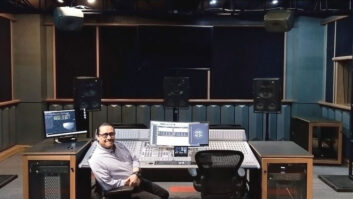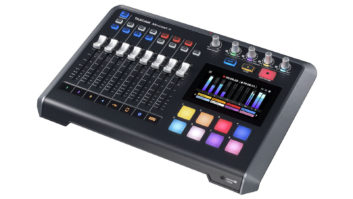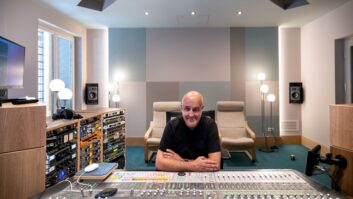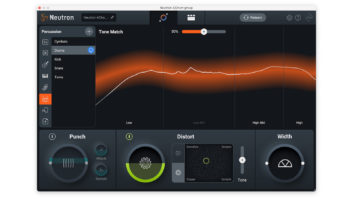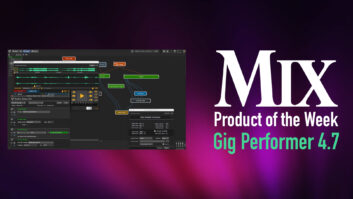

If you’d rather record all-electronic instrumentals than eat or sleep, then the release of Reason 4 ($499, $129 upgrade) will make your life complete. Propellerhead’s flagship workstation has been beefed up with an amazing new synthesizer, a redesigned and much-improved sequencer, a multichannel groove engine and other enhancements.
I’ve used Reason often in the past, both as a ReWire client and for complete pieces of music. The new version is destined to become a mainstay in my software arsenal. Yet Reason 4 remains maddeningly insular. It still has no audio inputs, lacks audio tracks and won’t host third-party plug-in synths or effects. A ReWire host DAW can add the audio tracks and plug-ins, but when you ReWire Reason to a DAW, your projects will be stored in two separate files, which means a bit of extra housekeeping.

Thor boasts multiple oscillator and filter types, a deep modulation matrix and a step sequencer. The main sequencer is visible in the lower pane.
IN A NUTSHELL
Reason provides an open-ended rack of synths and effects, which are tightly integrated with a MIDI sequencer. The synths include an old-school analog type; an unusual, exotic-sounding granular instrument; a full-featured multi-sampler; a REX file player; a 10-channel drum sample player; and now Thor, which is semimodular and provides several types of synthesis. Reason’s effects are fairly standard: A highly programmable reverb, a versatile distortion processor, a suite of mastering effects and a vocoder head the list. Also on tap are a step sequencer and a new arpeggiator. Groups of devices can be tucked away in a shell called a Combinator, which makes it easy to store and recall complex signal chains.
Reason’s devices can be patched to one another using “rear panel patch cords.” This turns the rack into a fully modular sound design environment, allowing me to create complex effects. For example, Reason lacks a stereo delay line, so I’ll tuck two or three DDL-1 delay modules in a Combinator with a line mixer, and perhaps add a Scream distortion unit or PEQ-2 parametric equalizer patched into a delay feedback loop to focus the echoes in one frequency range.
The program’s user interface is elegant, and the included sound library is versatile. Reason is strongest in dance and other pop music styles, but including tempo and time-signature changes in Version 4 is sure to grab film composers’ attention.
MEET THOR
To get my session running, I easily installed Reason from my DVD drive using only a serial-number entry. Within minutes, I had created a Thor “polysonic” synthesizer and was drooling over its hundreds of factory presets. Most of the sounds I loaded were inspiring.
But there’s more to life than factory presets. Thor has three oscillator and three filter slots able to hold six oscillator modules and four filter modules, plus four envelopes, two LFOs, its own delay and chorus effects, and a basic 16-step sequencer. Missing from Thor’s tool chest are multisegment envelopes. Propellerhead’s strong preference for putting all functions on the front panel limits envelopes to ADSR, or at, most, the DAHDSR (Delay, Attack, Hold, Decay, Sustain, Release) provided as Thor’s global envelope. However, adding multisegment loops using automation is easy.
For each oscillator, you can choose analog, wavetable, phase modulation (inspired by the Casio CZ Series synths), an FM carrier/modulator pair, a Multi Osc — in which several waves are detuned from one another by a controllable amount — or a noise generator. I was soon developing my own patches. (To hear a patch I created using band-limited noise and AM, go to www.mixonline.com and download HauntedHalls.mp3 from Mix Media.)
The formant filter sounds great and is very playable thanks to a mousable X/Y pad and a gender knob. Positioned between the filters is a waveshaper, and the routing of signals from oscillators through filters and shapers is quite flexible. For one patch, I routed a pair of sawtooth waves (rich in overtones) through a formant filter whose X and Y axes were being modulated by separate envelopes. I waveshaped the result using the soft-clip setting to add some filth and then dialed back the highs by sending the waveshaper’s output through a lowpass filter. I just about couldn’t stop programming sounds long enough to finish writing this review!
Adding to Thor’s power is a modulation matrix. The possible matrix inputs include not only the expected envelopes and LFOs, but also MIDI controllers and audio rate signals. With the latter, you can do FM between one oscillator and another. I tried sweeping a self-oscillating lowpass filter for that classic Minimoog side-bands effect. By using any of the four audio inputs on the back panel, you can route an external signal from another Reason module through Thor’s filters or use the signal to FM an oscillator. To test this, I routed a Dr. REX beat to two oscillators to produce a grinding percussion groove, which I processed through a pair of formant filters. The possibilities are limitless.

Groove depth, slide, and shuffle are all instantly available on Reason’s ReGroove mixer. Each of the 32 groove channels can be assigned its own groove template.
Thor’s rear panel control I/O goes further than any other Reason device. Four general-purpose CV I/Os are provided, as are ins and outs from Thor’s internal step sequencer. I used these to create a complex step-sequence pattern using the step sequencers in two Thors to drive a single oscilattor’s pitch.
SEQUENCER HAPPY
Judging from the user forums, some existing Reason users don’t care for the new sequencer. My advice: Read the manual. Many things have changed, but the sequencer is better.
Data is now recorded into clips, and a new razorblade tool can be used for slicing clips apart. Parameter automation is now vector-based and edited by dragging the breakpoints on standard multisegment envelopes. The default value of automated parameters is now adjustable, a detail that longtime Reason users will appreciate.
Each Reason device is now limited to a single sequencer track, but a single track can have as many “lanes” as you like. Lanes can be separately muted and unmuted, and given their own names, as can individual clips. This offers some convenient ways of overdubbing.
Tempo and time-signature changes can be inserted in a dedicated transport track. Reason has no hit points for aligning meter time with SMPTE time, but because you’d need a host DAW to view video, this may not be a real issue. Pattern-based devices such as Redrum and Matrix start over at the top of their current pattern when a time signature event is encountered so you can reinsert 4/4 at any point to keep patterns lined up after an odd-length phrase.
A floating Tools palette provides quick access to edit processes, including quantization, transpose, velocity and note-length processing, and legato overlap. And when an event is selected, its data values can be edited in an Inspector strip that runs along the top of the window.
GET INTO THE GROOVE
ReGroove takes the idea of groove templates to a whole new level. Reason gives you 32 channels of groove and a bunch of groove presets with which to work. Naturally, you can also create and save your own grooves. Each lane in each note track can be routed through any of the 32 groove channels.
Each groove channel has a master slider with which you control how gently or mercilessly the template is applied to incoming notes. Knobs for shuffle and time offset are also found in each channel. In the Tools palette, you can separately adjust the amount of effect on timing, velocity, note length and random timing in each channel. The master slider in the channel area attenuates these four controls. And because the track data is not being altered, groove changes are undoable.
I tried out some of the grooves by recording a few bars of straight 16th-note hi-hat. Subtle amounts of ReGroove added a lifelike quality, while larger amounts sounded jerky or bizarre. I doubt I’ll use ReGroove much unless I’m adding shuffle to individual lanes, but hip hop producers may find it indispensable for that off-center vibe. Listening to the grooves is the only way to find out what’s in them: The data can’t be inspected and the manual gives few details beyond noting that some of them were created by analyzing the feel of the Akai MPC60 or the rhythms on classic hit records from the days of vinyl.
THE UPGRADES CONTINUE
The Combinator programmer has been enhanced with a transposition parameter and filters for MIDI controllers, both of which assist in setting up playable layered instruments. All of the synth-type modules now have CV inputs for the mod wheel and pitch bender, which makes it easier for the new RPG-8 arpeggiator to throughput these types of data.
The arpeggiator has a few modes that go beyond up/down, as played and random. Its note output can be rendered to a track for editing. A row of buttons can be activated to produce rests in a pattern up to 16 steps long — and these buttons can be automated, which adds considerably to the arpeggiator’s power as an ostinato generator. The arpeggiator is also handy as a MIDI-to-CV converter, as its mod wheel, pitch-bend, after-touch, expression (CC 11) and breath controller (CC 2) output jacks can be patched to any CV input in Reason. Even so, I’m disappointed that it’s monophonic. Arpeggiators that can be programmed with chord steps are common these days and Propellerhead missed a beat here. Sometimes, not changing the software is just as important. I loaded a song I had recorded last year using Cubase SX 3 and Reason 3 (via ReWire) into Cubase 4 and Reason 4. It sounded exactly the same.
THE VOICE OF REASON
Thor moves easily into my Top Five list of favorite soft synths, and the improved sequencer and new arpeggiator make Reason 4 a winner. However, the sequencer’s user interface could be refined further. For instance, using the horizontal zoom-in button zooms in on the center of the displayed area, which can cause the playback point to slide out of view. And the click output is either on or off; there’s still no “click only during record” option. And I miss some of Cubase’s amenities, such as hearing a note when I click and drag on it in the track.
All that said, the old Reason sequencer was sorely in need of retooling, and Propellerhead has done a good job in updating it. For almost anyone who makes electronic music, from the serious student to the uptown studio pro, Reason 4 is too good to miss.
Propellerhead Software, dist. by Line 6, 818/575-3600, www.propellerheads.se.
Jim Aikin is a regular Mix contributor.

LISTEN: Must Play
A Reason 4 sketch using two of the author’s original Thor sounds


